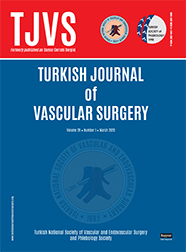
The Turkish Journal of Vascular Surgery
Yazarlar: Onur DOYURGAN, Uğur KARAGÖZ, Mustafa KARAÇELİK, Raziye Canan VERGİN, Osman Nejat SARIOSMANOĞLU
Konular:-
Anahtar Kelimeler:Catheters; child; intraoperative complications; postoperative complications
Özet: Objective: The aim of this study was to analyze the complications encountered during placement and use of subcutaneously implanted port catheters, and to review our experience on management of those complications in the light of the literature. Material and Methods: Medical records of 295 implantable subcutaneous port catheters placed in 267 patients between November 2010 and September 2016 in our clinic were retrospectively reviewed. Demographics, port dimension, localization of the intervention, the technique used, complications encountered perioperatively and in the long-term, and the causes of port removal were analyzed. Results: The numbers of females and males were 122 and 173, respectively, and the mean age of the patients was 6.1 ± 4.3 years (1 month-17 years). Total complication rate was 12.2% (n=36), and the most common complication was port infection (5.4%, n=16). Among the port infections, 7.8% (n=23) and 4.4% (n=13) developed at the intervention site, at internal jugular vein and subclavian vein, respectively. Perioperative complications and their rates were pneumothorax 1% (n=3), hemothorax 0.7% (n=2), malposition 0.7% (n=2), arterial injury 0.3% (n=1) and arrhythmia 0.3% (n=1). Long-term complications and their rates were port infection 5.4% (n=16), port thrombosis 3.5% (n=10), and broken port 0.3% (n=1). Port catheter was removed in 9.5% (n=28) of the cases due to complications. No statistically significant differences were found in overall complications, between the localization of the intervention, namely jugular and subclavian veins. Conclusion: Implantation of subcutaneous port catheters in pediatric patients who are pllaned to have any long-term treatment is a safe and preferred method. Increasing use of port catheters has resulted in an increased rate of associated complications. Notification and update of the knowledge of the physicians, nurses and the families of the patients may decrease the complication rate.